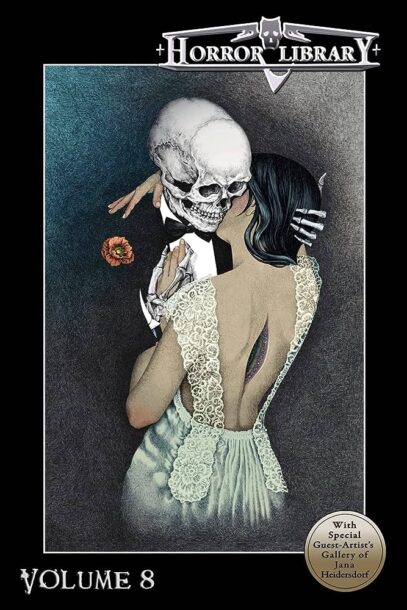 Edited By ERIC J. GUIGNARD (Dark Moon Books; 2023)
Edited By ERIC J. GUIGNARD (Dark Moon Books; 2023)
This, as the title indicates, is the eighth entry in Dark Moon Books’ HORROR LIBRARY anthology series. Being familiar with much of editor Eric J. Guignard’s previous output (which includes the collection THAT WHICH GROWS WILD and the previous two HORROR LBRARY volumes), I had high expectations for this book. I wasn’t disappointed.
The 31 stories collected here are distinguished by their eclecticism and shunning of traditional horror tropes. As Guignard promises in his introduction, “I love zombies and vampires and serial killers running amuck, but what I love more is fiction that innovates, tales that bring fresh perspectives…that latch onto ideas and transform them into something ominously alluring.” Culled from a reported 1,200 submissions, none of these stories are alike, and none take a predictable or expected path; there’s even a poem (“In Fear as Dark As Coal” by Ron Perovich) included in the lineup.
Among the stand-out entries is “Fishers Of–” by Frances Ogamba, which offers a novel take on the theme of soul snatching; the story is told from the point of view of an individual who makes soul “haulings,” and details what occurs when one such hauling goes horrifically wrong. “Story of her Life” by Tom Johnstone is another goodie, a slipstreamy tale that involves writing, masks and a fateful contract. I’m also quite partial to “Mazu—Goddess of the Sea” by Ai Jiang, which offers up a feast of highly baroque, sensually oriented language in its account of a man in love (literally) with the sea.
The most prominent name here is Steve Rasnic Tem, who offers “H is for The Hunt,” a highly perverse and surreal (and thus very Tem-esque) variant on the old TWILIGHT ZONE episode “Nothing in the Dark,” with a fortyish woman alone in a cottage, where she’s assailed by troubling visitations. While on the subject of recognizable names, there’s “Lines” by Lauren O’Donoghue, a well written, poignant account of a grieving widow and a fortune teller known—tellingly—as Bathory, and “Solace” by Anna Ziegelhof, a highly terse (single-sentence paragraphs predominate) and insular account of a newly hired employee at a creepy organization run by an individual named Kali.
In “The Yearning Pool” by Thomas P. Balázs, a young (male) virgin is deflowered in a manner that’s deeply horrific yet oddly tender. “Under the Pale Blue Moon” by Garick Cooke adds a dash of science fiction to its narrative about a race of fearsome creatures who live to hunt humans. “A Dormant Concern” by Charles Wilkinson (of the Eibonvale Press collection THE JANUARY ESTATE) is a notably subdued, yet decidedly haunting, recounting of some uncanny occurrences in the life of a widowed man.
Old fashioned claustrophobic unease is provided by R.A. Busby’s “Only the Stones will Hear you Scream,” about a crawl through a very tight passage called Daddy’s Home–a name that becomes quite appropriate in the story’s later passages. Further no-frills grotesquerie occurs in “We Can’t Let Go” by Sheldon Higdon, a gruesome exploration of motherly bonds with a Richard Matheson-esque final twist.
There’s also “Blockchain” by Dexter McLeod, an apocalyptic tale the book’s editor calls “so very, very dark,” and “Zipper Back” by Thersa Matsuura, who describes the story, quite accurately, as “JOHNNY GOT HIS GUN meets Kaiju.” Sounds good to me!
The book’s final pages consist of a mini-gallery of artwork by the German artist Jana Heidersdorf. On display are several black and white compositions that feature eyeless cats, gothic structures and Lovecraftian sea creatures, with traditional painting and digital rendering mixed into a highly individual whole. Heidersdorf, according to the contributor bio included here, has illustrated several children’s books, and her artwork does indeed evidence a childlike sheen, partnered with a very grown-up grasp of the macabre.
